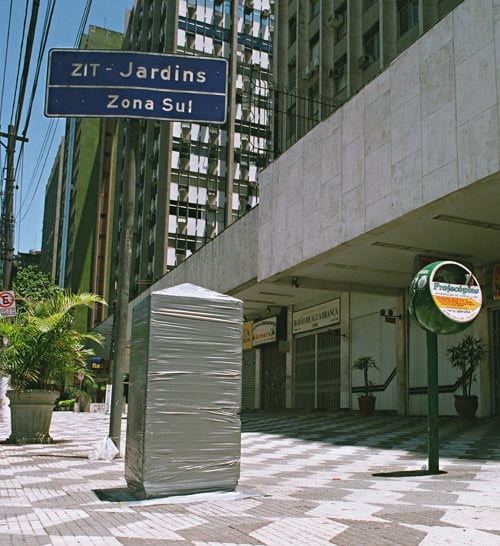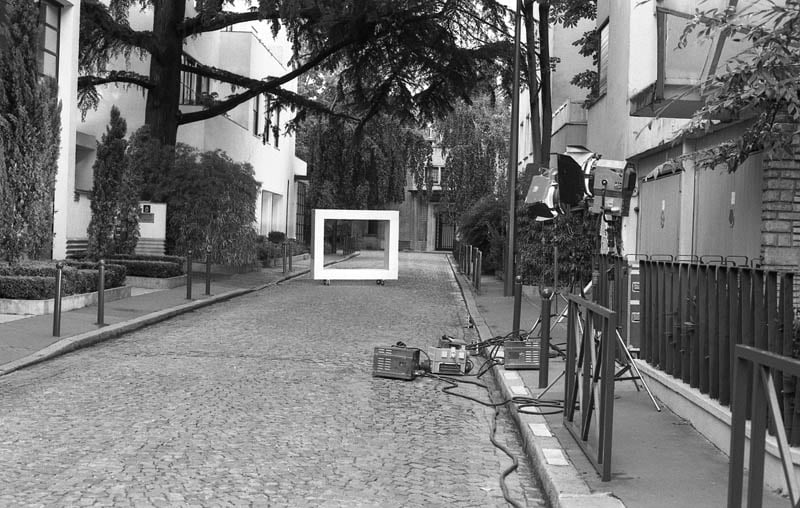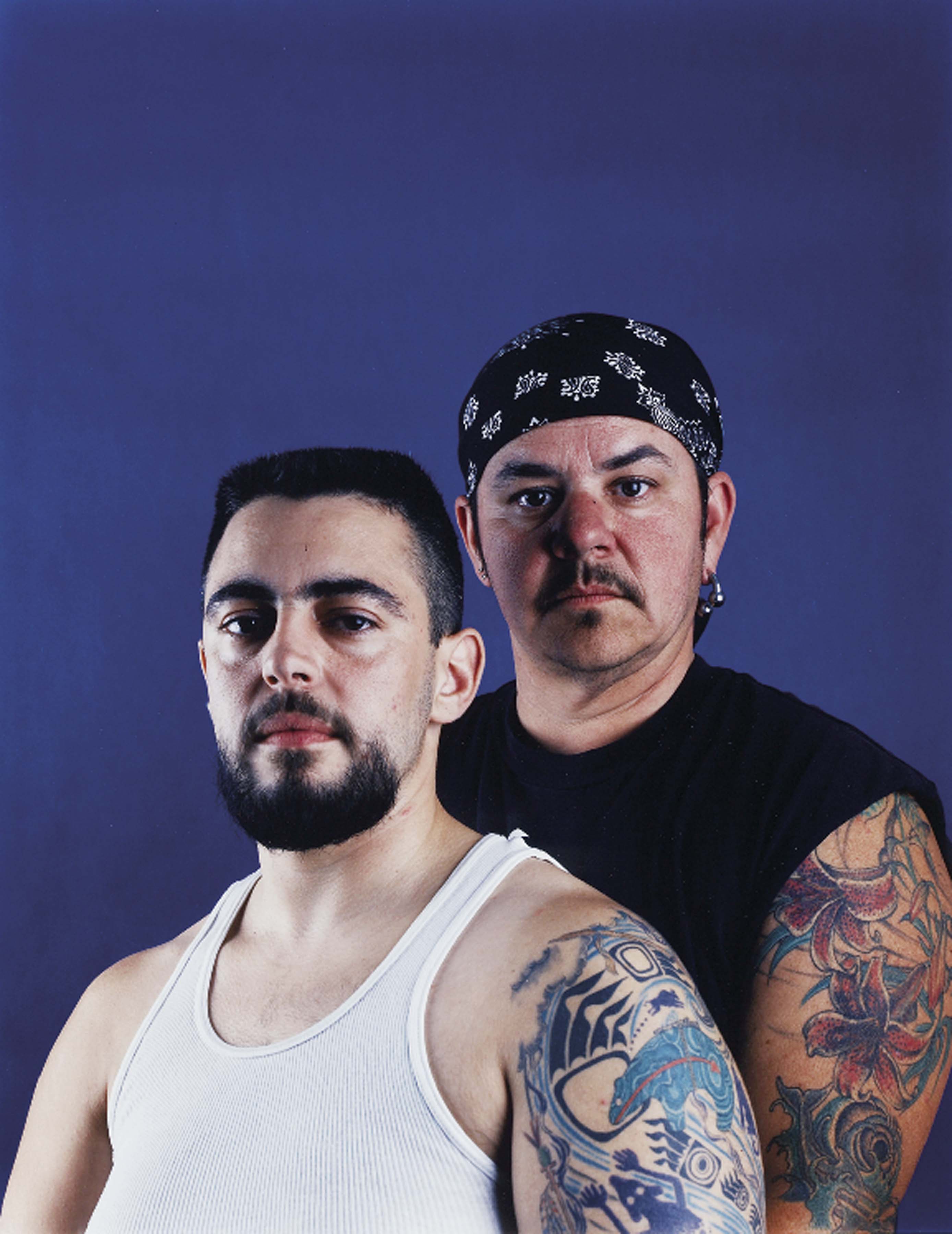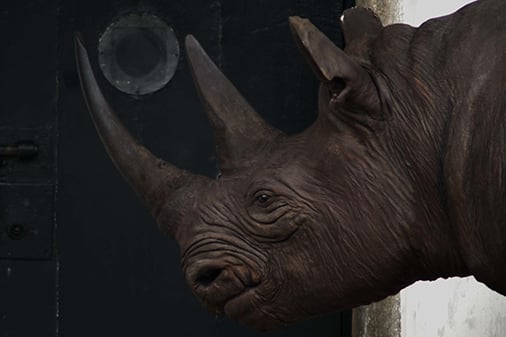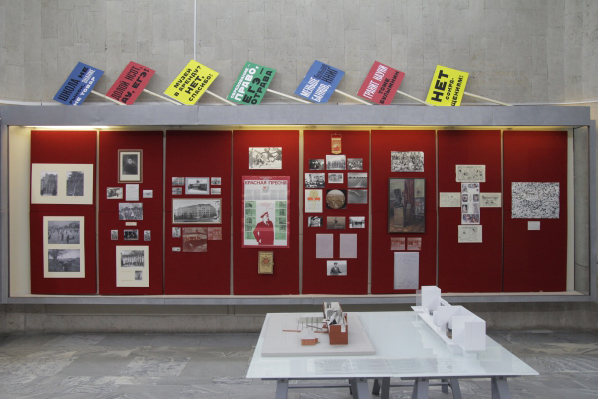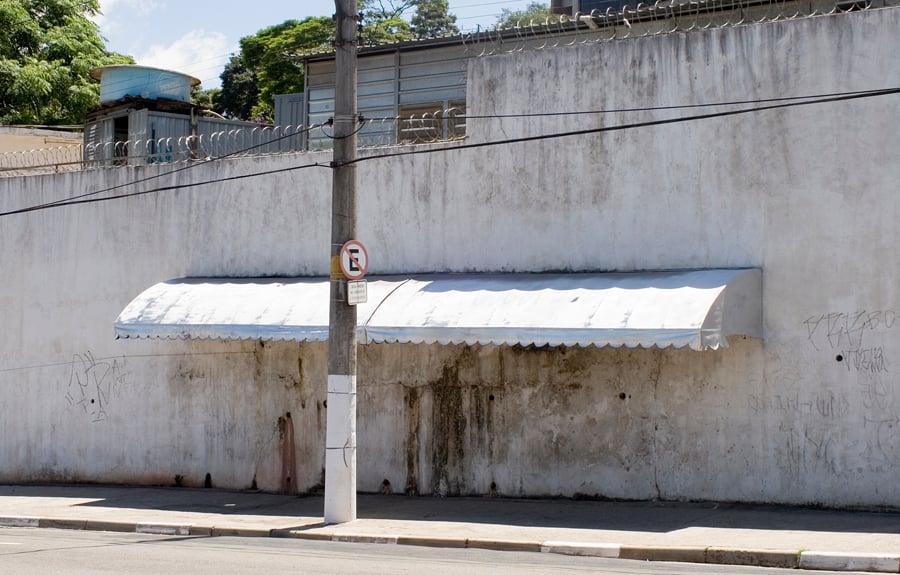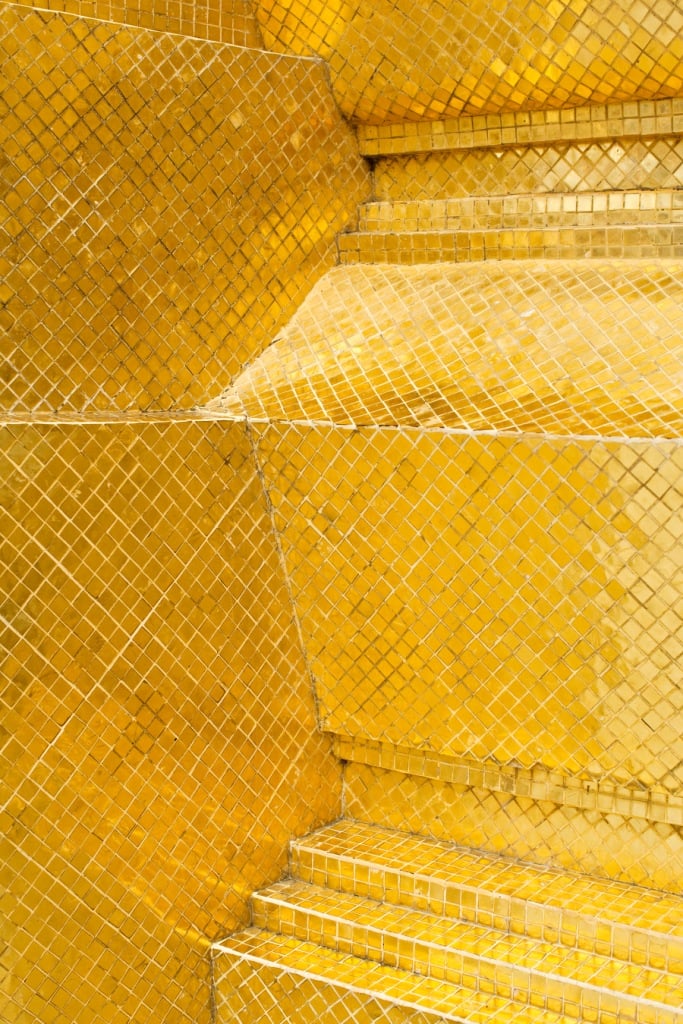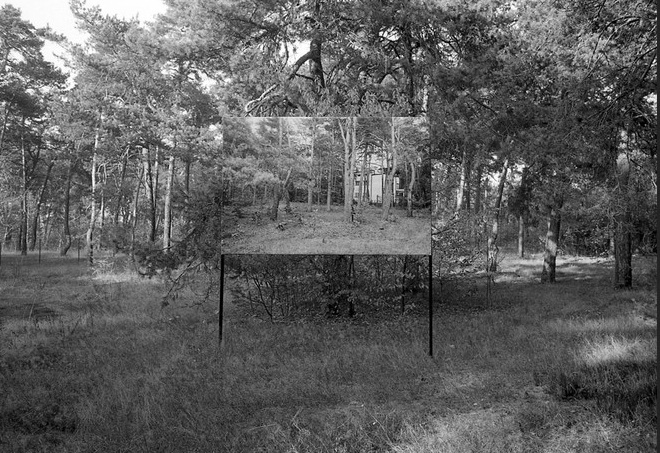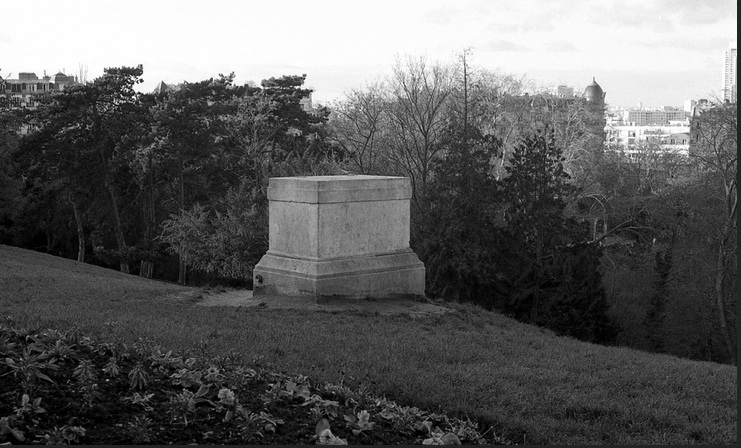
© » KADIST
Bahar Noorizadeh
The Red City of the Planet of Capitalism is part of a three project lineage, following Bahar Noorizadeh’s research on the architecture of the Soviet Union. The video focuses on the peculiar story of the Russian architect Moisei Ginzburg, who, in the late 1920s, suddenly turned his back on Le Corbusier, the French father of urbanist modernism. While Ginzburg had been a fervent follower of Le Corbusier’s philosophy, the story says that he was converted to disurbanism in only half an hour by the urban sociologist Mikhail Okhitovich.

© » KADIST
Chantal Edie and Zacharie Ngnogue
Au non de la liberté (Tiko drink Kumba drunk) is a photographic series by Zacharie Ngnogue and Chantal Edie that considers the correlation between those who hold power in Cameroon and how their actions affect the populations they rule in often compromising ways. “Tiko drink-Kumba drunk” is an adage that is commonly used in the Southwest province of Cameroon to speak of how one’s actions affect others. Civil liberties are next to non-existent in Cameroon, the law is lawless, and structured in a way that is intended to attack its citizens’ human rights.

© » KADIST
Nikita Gale
RUINER III by Nikita Gale is part of an on-going numbered series of abstract sculptures in which various ancillary materials necessary for sound production and recording such as towels, foam, and audio cables, are riddled around piping resembling crowd control bollards, lighting trusses, and other like stage architecture. While these muscular works evoke the forms and dynamism of mid-century modernism, they can also be seen as a translation of Goethe’s idea that “architecture is frozen music”. RUINER III is exemplary of how the artist’s disembodied sets typically evoke a sense of longing through absence, and in so doing, draw out an extended mediation on how audiences project mental or emotional energy onto a person, object, or idea.

© » KADIST
Shu Lea Cheang
Reflecting upon the transformation of surveillance techniques since the panopticon to include contemporary 3-D facial recognition, AI, and the Internet, Shu Lea Cheang’s 3x3x6 – 10 cases 10 data restages the rooms of the Palazzo delle Prigioni—a Venetian prison from the sixteenth century in operation until 1922—as a high-tech surveillance space. Taking as its starting point the story of libertine writer Giacomo Casanova, imprisoned in the Prigioni in 1755, Cheang has conducted in-depth studies on ten historical and contemporary cases of subjects incarcerated because of gender or sexual dissent, including the Marquis de Sade and Michel Foucault, as well as contemporary cases from Taiwan and South Africa. Their fictionalized portraits become part of the exhibition’s system; the title of which refers to today’s standardized architecture of industrial imprisonment: a 3 x 3 square-metre cell constantly monitored by 6 cameras.

© » KADIST
Basma Alsharif
Deep Sleep draws from historical avant-garde cinema to produce a poetic, sound-based meditation following brainwave-generating binaural beats. The dreamlike video is filmed among abandoned ruins in Malta, Athens, and Gaza, connecting the three locations in an attempt to convey the experience of being in Gaza from these monumental sites. Colorful flickering lights, sun, earth, stone, rock, sky, and water inundate the scenes, and the rhythmic sounds of waves, chimes, and footsteps remain.

© » KADIST
Diane Simpson
Simpson’s sculptural practice connects architecture, clothing, furniture and the body to explore the functional and sociological roles and the influence of the design and architecture of various cultures and periods in history. Her sculptures hold very specific references and are developed and transformed through revised drawings to create hybrid forms that are directed by her means of construction and choice of materials.
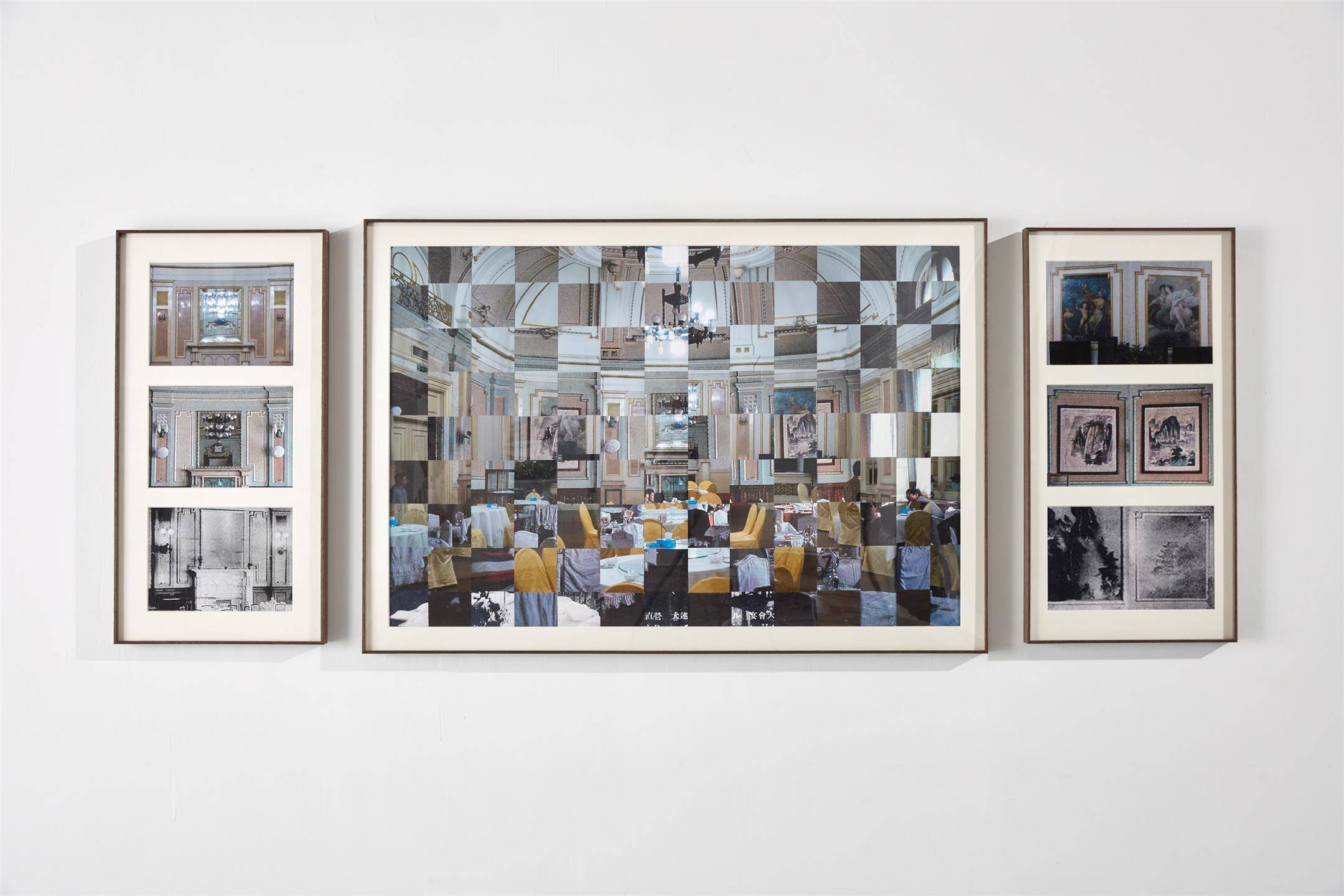
© » KADIST
Luka Yuanyuan Yang
Composed of three photographic panels, Three Times at Yamato Hotel by Luka Yuanyuan Yang is a part of the artist’s ongoing project Dalian Mirage , a seven act play in a theatre staged as the city of Dalian. This modern city was built by the Russian Empire in 1898 and occupied by Japan between 1905 and 1945. Based on historical investigations, Yang created ten characters, including a Dalian-born Japanese writer and a Dalian-born American immigrant.

© » KADIST
Curtis Talwst Santiago
Curtis Talwst Santiago has been creating intimate and performative environments within these small spaces for several years; the artist used to carry them around to show visitors one on one, opening up a scene in the space of his hand. Santiago considers these mobile box enclosures a method of transporting narratives of home and intimacy, diasporic identity, and experiences most often hidden or concealed from view. These Walls is a sculptural piece made from a reclaimed jewelry box, clay, paint, wool, plastic figurines, and human hair.
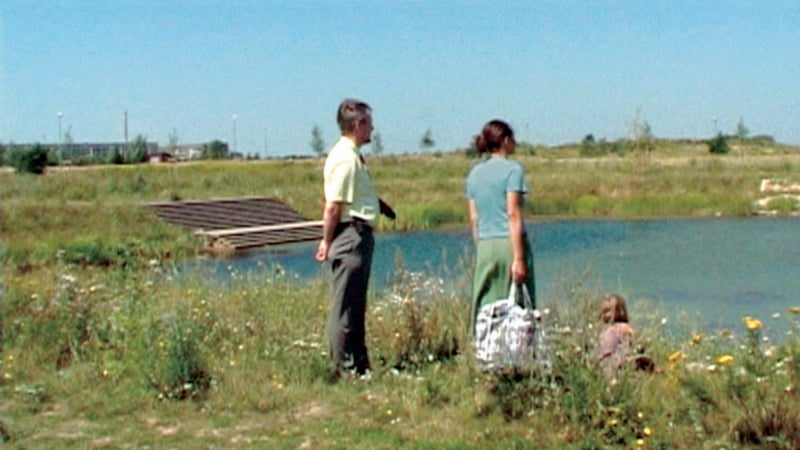
© » KADIST
Clemens von Wedemeyer
Die Siedlung is a filmic documentary about the recent shift in housing developments in Leipzig-Grünau in former East Germany and its consequences on some inhabitants. It complements von Wedemeyer slightly earlier and more artistic film Silberhöhe (2003) which decried imposed Modernist living model. In Die Siedlung , a voiceover describes and criticizes the different sites on view while the camera moves slowly past a vast abandoned 1930s Nazi army barracks which has yet to be converted or demolished, the building site and wastelands for the new private single family housing area, a constructed pond and finally the 1960s or 70s communal blocks of flats.

© » KADIST
Tamar Guimarães
Canoas by Tamar Guimarães is a film made for the 2010 São Paulo biennial as an exercise in the projection of national identity. The main subject and setting of the film is Casa das Canoas, the home that architect Oscar Niemeyer built for himself in the early 1950s. Overlooking the bay on the outskirts of Rio de Janeiro, the building has achieved iconic status in Brazil.

© » KADIST
Oren Pinhassi
Oren Pinhassi’s work examines the relationship between the human figure and the built environment. His hybrid sculptures, often somewhat emaciated, hover between the figurative and the architectural. In the case of The Crowd , a series of sculptures which evince architectures of control – where humans act and exert power – we find voting booths, segregation cells, institutional desks, places where bureaucratic exchange become spaces of bodily desire, complete with sexual appendages.

© » KADIST
Daniela Ortiz
In her work, Maids Room (2012) which is part of a series, Daniela Ortiz undertakes an architectural analysis of the houses belonging to the upper class of Lima. Her research highlights the position of ‘service architecture’, the vital space given to the domestics. The project offers an analysis of this room, its size and its position in relation to the rest of the house.

© » KADIST
Sung Hwan Kim
An early work in Sung Hwang Kim’s career, the video Summer Days in Keijo—written in 1937 is a fictional documentary, the film is based on a non-fiction travelogue, In Korean Wilds and Villages , written by Swedish zoologist Sten Bergman, who lived in Korea from 1935 to 1937. In Kim’s film, a Dutch female protagonist traces Bergman’s path in the present-day Seoul (Keijo was the Japanese name for Gyeongseong, currently Seoul). The protagonist navigates through spaces that have been rebuilt since the 1950s onwards, and the scenes are narrated by a voice-over based on Bergman’s written description of the modern city in 1937.

© » KADIST
Hassan Massoudy
Drawing & Print (Drawing & Print)
Ranging from Baudelaire to the Koran, each of Hassan Massoudy’s drawings are titled with a quotation from a text. In the case of La beauté sauvera le monde, the text originated from Dostoyevsky’s The Idiot , alluding to aspirations, models of behavior and words of wisdom. The image itself, though generated in a hybrid manner relating to Arabic and Japanese calligraphy, suggests both fluttering flags and buildings rising high out of the desert as one would see in many developing Middle Eastern countries.

© » KADIST
Rocky Cajigan
From the Ending by Rocky Cajigan consists of an assemblage painting, with accompanying sculptural objects presented on the floor. The bright pink object central to the painting is based on a photograph, and the artist’s personal memory, of a Bontoc ancestral tomb, commonly located at close proximity to a family home. The painting is covered by a net material simulating a fence, creating a certain bodily distance from the viewer’s perspective.

© » KADIST
Oliver Beer
Pay and Display is a film of a performance, for which there was no audience, staged in the multistory Pershore Street car park in Birmingham, a brutalist building, arguably one of the most inhospitable environments for a musical performance. Dilapidated and empty, the ghostly presence of the car park comes to life. Beer composed the piece to resonate with this architecture, finding the frequencies that would bring the building to life, acting as a sound box and in effect another voice.

© » KADIST
Louisa Bufardeci
Ground Plan by Louisa Bufardeci is a large-scale, digitally-printed, architecturally rendered, wall drawing that pictures the permitted global flow of the world’s population. Utilizing data from UNESCO, the national census, opinion polls, and the CIA World Factbook, Bufardeci presents each country as a room in a labyrinthine building. Each room is composed of sometimes incomplete walls, with open or closed doorways, in reflection of their border immigration policies; each room is scaled according to its population density.

© » KADIST
Marlon de Azambuja
Following a series of related works, Brutalismo Americano by Marlon de Azambuja is a site-specific sculptural installation produced during the artist’s residency at Kadist, San Francisco in 2017. Treating the city as an object of attention, de Azambuja collected building materials from the surrounding area over a period of ten days to conceive of an architecture in situ. The work is not meant to mimic any of San Francisco’s own architecture, or to be a maquette or portrait of the cityscape, but instead a singular, constructive gesture.

© » KADIST
Luisa Lambri
Lambri’s careful framing in Untitled (Miller House, #02) redefines our understanding of this iconic mid-century modernist building located in Palm Springs, California. Commissioned by industrialist J. Irwin Miller and his wife Xenia Simons Miller, and built by Richard Neutra in 1937, the Miller house’s open and flowing layout expands upon modernist architectural traditions. It features a flat roof, stone and glass walls, with rooms configured beneath a grid pattern of skylights and supporting cruciform steel columns.
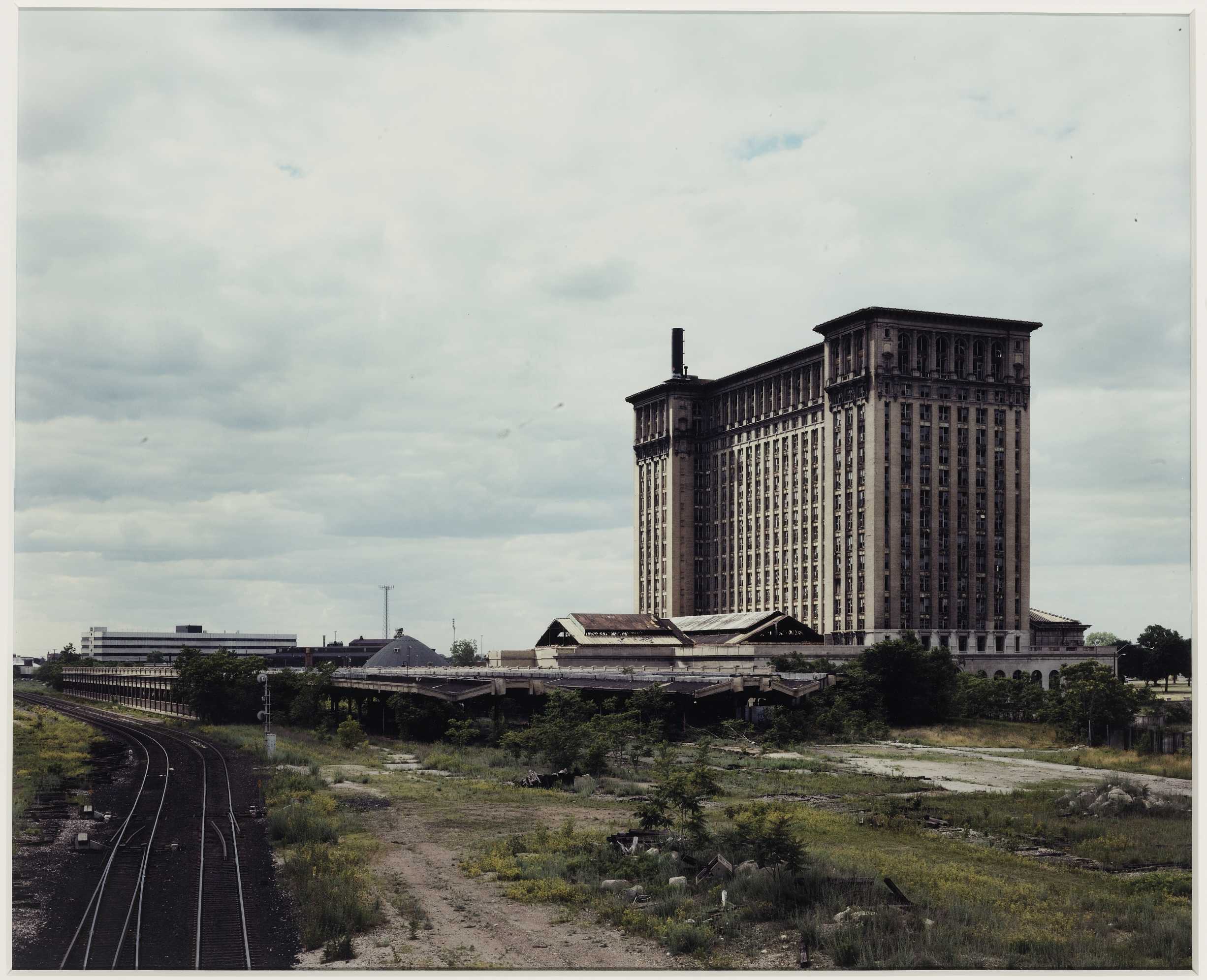
© » KADIST
Stan Douglas
Michigan Central Station is part of a larger photographic series, Detroit Photos , which includes images of houses, theaters, stadiums, offices, and other municipal structures. Continuing his fascination with failed modernist utopias, Douglas depicts Michigan Central Station as a monolithic, almost prison-like structure lording over a desolate landscape. Once the hub of industrial transportation, the station is now devoid of any human activity and lies fallow, surrounded by train-less tracks and vegetation-less ground.

© » KADIST
William E. Jones
In the early 20th century, the Hercules Engine Company was doing a brisk business producing customized, heavy-duty engines. Seventy years later, when the United States military started opting for Humvees and stock parts, the company began to fail, and it entirely ceased production in 1999. Hercules Engines, Abandoned, Canton, Ohio (2011) depicts the manufacturer’s former productive core, gone fallow.

© » KADIST
Marcelo Cidade
Marcelo Cidade interrogates the city, architecture and urban planning. This architectonic drawing proposes modular possibilities, adaptable variations based on the form of the concrete block (a material which is often actually integrated in his practice). The “re-definition” announced in the title is in construction, in process, under development, in flux.

© » KADIST
Gabriel Sierra
Untitled consists of a small wooden sculpture that leans against a wall. Here, a rectangular piece of wood holds a folded article from a vintage design magazine whose Italian text states: “Villa per una persona sola. Arquitectura Pasadena California.” On the flipside of the paper is a feature with different images of paintings and architecture, including a painting by Piet Mondrian.

© » KADIST
Tomoko Yoneda
Yoneda’s Japanese House (2010) series of photographs depicts buildings constructed in Taiwan during the period of Japanese occupation, between 1895 and 1945. Yoneda focuses both on the original Japanese features of the houses and on details that have been altered since the end of the occupation. The yet-to-be acknowledged history of the occupation of Taiwan and other East Asian countries by Japan during World War II is subtly disclosed in these pictures.

© » KADIST
Erin Shirreff
Erin Shirreff’s A. P. series of prints investigates how objects are “constructed” at the level of the image. For each composite photograph, Shirreff fabricates two sculptural forms from what appear to be metal or plaster, although the precise materials are unidentified. Her sculptures resemble miniature architectural models or renderings of buildings as-yet-to-be fully conceptualized, both elemental and elegant in their use of sharp angles and clean lines.

© » KADIST
Tina Modotti
The Italian photographer Tina Modotti is known for her documentation of the mural movement in Mexico. She had a keen eye for architectural composition, and captured eloquent details using a delicate platinum print process. In 1929 she was deported from Mexico because of her involvement in the Communist party and went to Europe.

© » KADIST
Clarissa Tossin
Clarissa Tossin’s film Ch’u Mayaa responds to Frank Lloyd Wright’s Hollyhock House (constructed 1919–21) in Los Angeles, an example of Mayan Revival architecture. By re-appropriating the structure as a temple and imbuing it with a dance performance based on movements and postures found in ancient pottery and murals, the choreography takes its influence from the house’s design and the body positions on ancient Maya ceramics and buildings. A pulse, breathing, and a pre-Columbian clay flute are among the sounds on the soundtrack.

© » KADIST
Chris Johanson
Apartment on Cardboard (2000) is an exterior view of an abstracted apartment building. Viewers unwittingly become voyeurs, peering through the rectangles that stand for windows and observing the residents therein, who ponder questions both mundane and existential: “Where is Ron now?” and “What have I become?” The queries and characters are treated democratically—not judged, praised, or subjected to hierarchy. While their thoughts are specific, the painting captures a universal urban activity: looking across to the building next door and wondering about its residents, all the while knowing that they have probably looked over and wondered about us, as well.

© » KADIST
Leslie Shows
Human Quarry is a large work on paper by Leslie Shows made of a combination of acrylic paint and collage. Both through its title and formally—through how the shapes in the composition resemble a mountain or natural formation—the piece relays us to a mineral quarry or a deep mining pit where materials are extracted. Interspersed among the block-like figures and rocky textures, we also see several human silhouettes, either cut-out, or as if they were whited out by a shining light, or lost in the shadows.

© » KADIST
Catherine Opie
Although best known as a provocateur and portraitist, Opie also photographs landscapes, cityscapes, and architecture. The Freeway Series was developed in 1995, right after the artist’s inclusion in that year’s Whitney Biennial. As if suggesting that her work should not be restricted to being seen through overtly political or activist lenses, this series lends insight into the city of Los Angeles via its most characteristic urban feature: its highways.
Chantal Edie and Zacharie Ngnogue
Chantal Edie and Zacharie Ngnogue are a photography duo who channel their personal experiences into social commentaries...
Juan Araujo
- year born: 1971
- gender: male
- nationality: Spanish
- home town: Caracas, Venezuela
Rocky Cajigan
Rocky Cajigan is a Bontoc Igorot artist working in the contemporary contexts of Indigenous people from the Cordilleras region in the northern state of Luzon island in the Philippines...
Luisa Lambri
- location: Los Angeles, California
- year born: 1969
- gender: female
- nationality: Italian
- home town: Como, Italy
Chris Wiley
- location: New York, New York
- year born: 1981
- gender: male
- nationality: British
Charlotte Moth
Charlotte Moth has been constituting an image bank since 1999...
Carlos Garaicoa
- location: Madrid, Spain
- year born: 1967
- gender: male
- nationality: Cuban
- home town: Havana, Cuba
Bettina Pousttchi
In recent years Bettina Pousttchi’s work has dealt with themes related to memory, time and history and she is particularly interested in the consequences of the fall of the Berlin Wall...
Vaclav Pozarek
Growing up in Czechoslovakia, Vaclav Pozarek experienced political aggression, spying and ludicrous impediments...
Clemens von Wedemeyer
- location: Göttingen, Deutschland
- year born: 1974
- gender: male
- nationality: German
Nora Schultz
Born 1975, Frankfurt / Main, Germany Lives and works in Berlin Nora Schulz explores the relations between painting, sculpture, performance, and language...
Leslie Shows
- location: San Francisco, California
- year born: 1977
- gender: female
- nationality: American
Diane Simpson
Diane Simpson is interested in a seamless shifting from body to architectural form in the melding of the wearable with the structural un-wearable...
Ryan Villamael
Ryan Villamael’s deeply layered practice is informed by a rare degree of skill and dexterity as well as by vivid imagination and haunting intellectual preoccupations...
Curtis Talwst Santiago
Curtis Talwst Santiago is a multimedia artist making work centered on the diasporic experience, transculturalism, and memory...
Jill Magid
Jill Magid is a conceptual artist specialising in the infiltration of control organs and power systems...
Marc Nagtzaam
1968, Helmond, the Netherlands...
Adrien Missika
Adrien Missika (1981, Paris, France) studied and developed his career in Lausanne where he founded 1m3 artspace...
Diego Marcon
Diego Marcon uses film, video and installation to investigate the ontology of the moving image, focusing on the relationship between reality and representation...
Camel Collective
Camel Collective comprises the artists Carla Herrera-Prats (Mexican, photographer and conceptual artist) and Anthony Graves (American, painter), who began working together in 2005 during a fellowship at the Whitney Independent Program...
Oliver Beer
The work of Oliver Beer explores the resonances in buildings and objects, exploiting the occurrence of natural frequencies that turn buildings and objects not only into amplifiers but musical instruments...
Catherine Opie
- location: Los Angeles, California
- year born: 1961
- gender: female
- nationality: American
- home town: Sandusky, Ohio
Bahar Noorizadeh
Bahar Noorizadeh is filmmaker, writer, and platform designer...
Basma Alsharif
Basma Alsharif is an artist and filmmaker of Palestinian origin, born in Kuwait, and raised between France, the US and the Gaza Strip...
Nagendra Gurung
Since the mid-2000s, Nagendra Gurung has practiced photography in parallel to his life as a migrant worker in Dubai and Saudi Arabia...
Lin Yilin
- location: Beijing & New York
- year born: 1964
- gender: male
- nationality: Chinese
- home town: Guangzhou, China
Majd Abdel Hamid
Palestinian artist Majd Abdel Hamid’s work is akin to an archeology of violence and trauma from which he unearths the materials that weave a web of new imagination...
-
1930-1939
Tina Modotti
1930The Italian photographer Tina Modotti is known for her documentation of the mural movement in Mexico...
-
1990-1999
Catherine Opie
1994Although best known as a provocateur and portraitist, Opie also photographs landscapes, cityscapes, and architecture...
Stan Douglas
1997Michigan Central Station is part of a larger photographic series, Detroit Photos , which includes images of houses, theaters, stadiums, offices, and other municipal structures...
-
2000-2009
Chris Johanson
2000Apartment on Cardboard (2000) is an exterior view of an abstracted apartment building...
Valérie Jouve
2000Like many contemporary photographers who play with the codes of realism, Valérie Jouve composes her images, having already a more or less predetermined result in mind, in order to deliver a complex representation of the world instead of a bold presentation of facts...
William E. Jones
2000His series, The Golden State, harkens back to his early career and his photographic training...
Raphaël Zarka
2001This photograph seems to be awaiting meaning, it more or less evokes known elements without really identifying with them completely: a motorway interchange, a bridge, an electric pylon… In fact this is the end of the tracks of the Aérotrain, a wheelless monorail invented by Jean Bertin in the 1970s, which acts like ‘a fossil of movement on landscape scale’, as explained by the artist...
Luisa Lambri
2002Lambri’s careful framing in Untitled (Miller House, #02) redefines our understanding of this iconic mid-century modernist building located in Palm Springs, California...
Clemens von Wedemeyer
2004Die Siedlung is a filmic documentary about the recent shift in housing developments in Leipzig-Grünau in former East Germany and its consequences on some inhabitants...
Abraham Cruzvillegas
2004Wright Imperial Hotel (2004) is a sort of bow and arrow made out of feathers, a São Paulo phone book, and other materials...
Nagendra Gurung
2005Chalis Katesi Ramaula is a series of 240 prints capturing Nagendra Gurung’s life, work, and colleagues from the construction sites where he has worked in Dubai and Saudi Arabia...
Marcelo Cidade
2006This series of photographs reflects Marcelo Cidade’s incessant walks or drifting through the city and his chance encounters with a certain street poetry like the Surrealists or Situationists before him...
Juan Araujo
Drawing & Print
2006(Drawing & Print) Many of Araujo’s works depict reproductions and Libro Ponti II is a recreation of a book on Italian architect Gio Ponti...
Sung Hwan Kim
2007An early work in Sung Hwang Kim’s career, the video Summer Days in Keijo—written in 1937 is a fictional documentary, the film is based on a non-fiction travelogue, In Korean Wilds and Villages , written by Swedish zoologist Sten Bergman, who lived in Korea from 1935 to 1937...
Luisa Lambri
2007Custom-built for a silent film star in 1934 in Santa Monica, the Sten-Frenke House is an idiosyncratic icon...
Hassan Massoudy
Drawing & Print
2008(Drawing & Print) Ranging from Baudelaire to the Koran, each of Hassan Massoudy’s drawings are titled with a quotation from a text...
Bettina Pousttchi
2009For Bettina Poutsttchi’s large-format, site-specific photographic work Echo (2009–10), the four exterior walls of the Temporäre Kunsthalle Berlin were covered with a digitally edited collage of archival images of the glass-and-steel facade of the Palast der Republik (Palace of the Republic), which had once been located nearby...
Jean-Luc Moulène
2009Head Box by J ean-Luc Moulène i s not the representation of a space but a real space that remains in the domain of sculpture which the artist develops in parallel with his photographic practice...
-
2010-2019
Tamar Guimarães
2010Canoas by Tamar Guimarães is a film made for the 2010 São Paulo biennial as an exercise in the projection of national identity...
Tomoko Yoneda
2010Yoneda’s Japanese House (2010) series of photographs depicts buildings constructed in Taiwan during the period of Japanese occupation, between 1895 and 1945...
Takahiro Iwasaki
2010Tectonic Model is made from a number of leather bound books piled up in different formations that resemble architecture on top of a sawhorse desk...
Meschac Gaba
2010The headdresses, woven from artificial hair braids, symbolize historical icons including Martin Luther King, Kwame Nkrumah, Fela Kuti and King Guézo of Dahomey...
Carlos Garaicoa
2010From the series the Old and the New (XI) by Carlos Garaicoa belongs to the series Lo viejo y lo nuevo / Das Alte und das Neue (The Old and the New) which was first exhibited in 2010 at Barbara Gross Gallery in Germany...
William E. Jones
2011In the early 20th century, the Hercules Engine Company was doing a brisk business producing customized, heavy-duty engines...
Oliver Beer
2011Pay and Display is a film of a performance, for which there was no audience, staged in the multistory Pershore Street car park in Birmingham, a brutalist building, arguably one of the most inhospitable environments for a musical performance...
William E. Jones
2011In Restaurant, Canton, Ohio (2011), a convenience store offers food, liquor, and Coca Cola to an empty street...
Daniela Ortiz
2012In her work, Maids Room (2012) which is part of a series, Daniela Ortiz undertakes an architectural analysis of the houses belonging to the upper class of Lima...
Diane Simpson
2012Simpson’s sculptural practice connects architecture, clothing, furniture and the body to explore the functional and sociological roles and the influence of the design and architecture of various cultures and periods in history...
Chris Wiley
2012Architectural details become abstracted renderings in Chris Wiley’s inkjet prints 11 and 20 (both 2012)...
Chris Wiley
2012Architectural details become abstracted renderings in Chris Wiley’s inkjet prints 11 and 20 (both 2012)...
Charlotte Moth
2012It is with the eye of a sculptor that Charlotte Moth records modernist architecture and its copies which she encounters during her trips and residences...
Charlotte Moth
2012It is with the eye of a sculptor that Charlotte Moth records modernist architecture and its copies which she encounters during her trips and residences...
Adrien Missika
2013Adrien Missika follows in the footsteps of the Brazilian landscape architect and artist Roberto Burle Marx (1909-1994), a designer of gardens, parks and promenades who introduced modern landscape architecture to Brazil...
Nora Schultz
2013Halfway between a painting and an installation City Sound of Rug gathers found images, synthetic foam, painted metal plates, and prints placed on the floor...
Basma Alsharif
2014Deep Sleep draws from historical avant-garde cinema to produce a poetic, sound-based meditation following brainwave-generating binaural beats...
Marc Nagtzaam
Drawing & Print
2014(Drawing & Print) Nagtzaam’s medium is drawing and his repertory of forms varies from abstract hard-edge and wall drawing to the reproduction of written material that he collects from art magazines...
Oscar Tuazon
2014Oscar Tuazon‘s sculptural oeuvre is situated at the border of art, architecture and technology...
Edie Fake
Drawing & Print
2015(Drawing & Print) Related to Edie Fake’s Memory Palaces series — reimagined facades of urban lesbian bars and gay nightclubs — Personal Business draws an association between architecture and the body, with ornamental structures that are decorative and protective...
Jill Magid
2016In 1995, the personal and professional archives of the Mexican architect Luis Barragán were acquired (including the rights to the name and the work of the architect) by the Swiss furniture enterprise Vitra...
Clarissa Tossin
2017Clarissa Tossin’s film Ch’u Mayaa responds to Frank Lloyd Wright’s Hollyhock House (constructed 1919–21) in Los Angeles, an example of Mayan Revival architecture...
Curtis Talwst Santiago
2017Curtis Talwst Santiago has been creating intimate and performative environments within these small spaces for several years; the artist used to carry them around to show visitors one on one, opening up a scene in the space of his hand...
Rocky Cajigan
2017From the Ending by Rocky Cajigan consists of an assemblage painting, with accompanying sculptural objects presented on the floor...
Marlon de Azambuja
2017Following a series of related works, Brutalismo Americano by Marlon de Azambuja is a site-specific sculptural installation produced during the artist’s residency at Kadist, San Francisco in 2017...
Rocky Cajigan
2017From the Beginning by Rocky Cajigan consists of an assemblage painting, with accompanying sculptural objects presented on the floor...
Beverly Buchanan
2017Made between 1986 and 2015, Buchanan’s Shack Sculptures are a result of the artist’s close observation and extensive research of ‘shotgun’ houses, where one room is arranged in sequence one behind the other; the rural poor inhabited these houses...
Diego Marcon
2017Monelle by Diego Marcon was filmed at night inside the infamous Casa del Fascio, the headquarters of the local Fascist Party in Como Italy, designed by Giuseppe Terragni under Mussolini’s rule...
Hulda Guzmán
2018Be Kind to Your Demons is a series of paintings by Hulda Guzmán that presents a variety of scenes in which female characters carry out ubiquitous activities in the company of secondary characters (mostly men) and devil-like creatures...
Camel Collective
2018Gated Commune , a video by Camel Collective, is a critique of the complex, and often obtuse, language used to describe sustainable development projects...
Shu Lea Cheang
2019Reflecting upon the transformation of surveillance techniques since the panopticon to include contemporary 3-D facial recognition, AI, and the Internet, Shu Lea Cheang’s 3x3x6 – 10 cases 10 data restages the rooms of the Palazzo delle Prigioni—a Venetian prison from the sixteenth century in operation until 1922—as a high-tech surveillance space...
Luka Yuanyuan Yang
2019Composed of three photographic panels, Three Times at Yamato Hotel by Luka Yuanyuan Yang is a part of the artist’s ongoing project Dalian Mirage , a seven act play in a theatre staged as the city of Dalian...
Ryan Villamael
2019Behold A City 4 extols the old grandeur of Manila, the nation’s storied capital – the complex nexus of heritage, modernity, and all sorts of compulsions, political or otherwise, that attempt to define it...
Majd Abdel Hamid
2019Tadmur by artist Majd Abdel Hamid is influenced by a book by Mustafa Khalifa titled The Shell: Memoirs of a Hidden Observer , which details Khalifa’s imprisonment in the Assad ‘desert prison’ Tadmur...
-
2020-2029
Chantal Edie and Zacharie Ngnogue
2020Au non de la liberté (Tiko drink Kumba drunk) is a photographic series by Zacharie Ngnogue and Chantal Edie that considers the correlation between those who hold power in Cameroon and how their actions affect the populations they rule in often compromising ways...
Oren Pinhassi
2020Oren Pinhassi’s work examines the relationship between the human figure and the built environment...
Nikita Gale
2020RUINER III by Nikita Gale is part of an on-going numbered series of abstract sculptures in which various ancillary materials necessary for sound production and recording such as towels, foam, and audio cables, are riddled around piping resembling crowd control bollards, lighting trusses, and other like stage architecture...
Chantal Edie and Zacharie Ngnogue
2020Au non de la liberté (Tiko drink Kumba drunk) is a photographic series by Zacharie Ngnogue and Chantal Edie that considers the correlation between those who hold power in Cameroon and how their actions affect the populations they rule in often compromising ways...
Chantal Edie and Zacharie Ngnogue
2020Au non de la liberté (Tiko drink Kumba drunk) is a photographic series by Zacharie Ngnogue and Chantal Edie that considers the correlation between those who hold power in Cameroon and how their actions affect the populations they rule in often compromising ways...
Patricia Esquivias
2020Cardón Cardinal by Patricia Esquivias is part of a series of video works in which the artist develops a narrative in front of her computer screen...
Bahar Noorizadeh
2022The Red City of the Planet of Capitalism is part of a three project lineage, following Bahar Noorizadeh’s research on the architecture of the Soviet Union...






